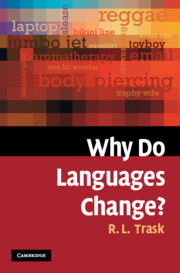Book contents
- Frontmatter
- Contents
- List of figures and tables
- A few words before we start
- Acknowledgements
- 1 How do languages change?
- 2 Why are languages always changing?
- 3 Where do words come from?
- 4 Skunk-Leek – my kind of town: what's in a name?
- 5 Where does English come from?
- 6 Why is American English different from British English?
- 7 Why is English spelling so eccentric?
- 8 Which is the oldest language?
- Some final thoughts
- Further reading
- Index
A few words before we start
Published online by Cambridge University Press: 05 June 2012
- Frontmatter
- Contents
- List of figures and tables
- A few words before we start
- Acknowledgements
- 1 How do languages change?
- 2 Why are languages always changing?
- 3 Where do words come from?
- 4 Skunk-Leek – my kind of town: what's in a name?
- 5 Where does English come from?
- 6 Why is American English different from British English?
- 7 Why is English spelling so eccentric?
- 8 Which is the oldest language?
- Some final thoughts
- Further reading
- Index
Summary
This book is intended to give a sense of language change to interested laypeople of any age; it is not a textbook. I do hope, however, that it will act as a door into historical linguistics for some readers.
Because of its nature, I have made no assumptions about knowledge either of languages or, more importantly, of the techniques linguists use to describe language. If we are going to treat the subject in any depth or seriousness, however, I have found it necessary occasionally to use special terms and symbols in the text. I normally explain these, but I want to discuss some potential sticking points before we start. Readers may well find themselves coming back to this page occasionally.
The Roman alphabet used for English is not terribly effective, as we will see, in representing the sounds of English, never mind the potential sounds found in all the world's languages. Because of this, phoneticians and other linguists who work with sounds have spent a considerable amount of effort over the last hundred years and more developing an extended writing system, the International Phonetic Alphabet (IPA), which can describe all of these sounds. I will not use more than a handful of these symbols in this book, and only when necessary.
- Type
- Chapter
- Information
- Why Do Languages Change? , pp. ix - xPublisher: Cambridge University PressPrint publication year: 2009



